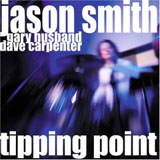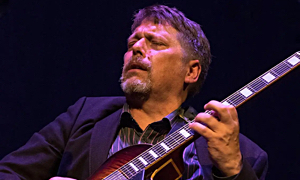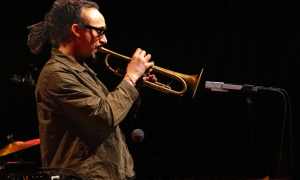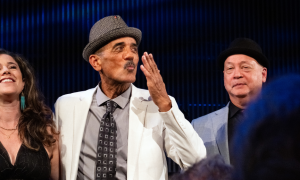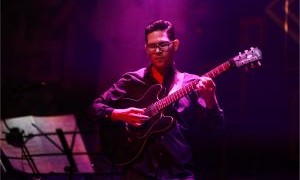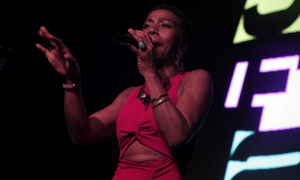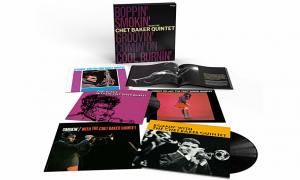Home » Jazz Articles » Live Review » Ottawa Jazz Festival Day 5: June 25, 2007
Ottawa Jazz Festival Day 5: June 25, 2007
With the opening night of the genre-busting four-day Improv Invitational series at the National Arts Centre's Fourth Stage, and an exhilarating performance by Finland's UMO Jazz Orchestra at the 10:30 PM Studio Series at the NAC's Studio, the TD Canada Trust Ottawa International Jazz Festival, once again, demonstrated that the definition of jazz is a far-reaching one that includes crossing over into areas of contemporary classical music, world music, and more. The Concert Under the Stars series at the outdoor Confederation Park may be targeted at a more general audience, but both the Improv Invitational and Studio series are clear evidence that the OIJF is about much more than simply following the mainstream tradition.
Chapter Index
John Geggie Group
Bassist John Geggie is well-known, not only to locals, but to AAJ readers as well, for his annual series of concerts at the NAC's Fourth Stage, where he brings in artists from across Canada and abroad to participate in performances that define the concept of music without a safety net. In past years he's collaborated with artists including Ben Monder, Craig Taborn, Bill Carrothers and Mark Dresser. So it's only fitting that, along with returning after a two-year absence to host the late night jam sessions, he should kick off this year's 8:00 PM Improv Invitational series with a show that, once again, demonstrates his commitment to unorthodox instrumental groupings and musical concepts.

Percussionist Pierre Tanguay is another well-known name to Ottawa audiences who has already performed with bassist Alain Bédard's August Quintette as part of the 6:30 PM Great Canadian Jazz series. He's a flexible percussionist, as comfortable with traditional swing as he is creating an expansive orchestral palette with the simplest of drum kits, a plethora of subtly different sticks and mallets, and vocalizations that, at times, resemble his own take on the Indian konnakol (vocal percussion) tradition but elsewhere add melodic ideas to the mix. He's a widely recorded artist, appearing on no fewer than thirty-four albums this year alone. Geggie has worked with Tanguay before, and for a concert based largely on free improvisation, with only a triptych of rallying tunes, he couldn't have picked a better percussion partner.
Pierre-Yves Martel may be less-known than Tanguay, but he's no less innovative. He's a skilled bassist whose Engagement & Confrontation (Actuelle, 2006) is an album of solo improvisations that demonstrates limitless potential through use of prepared techniques. For the past three years, however, he's been honing his skill on the viola da gamba, a stringed instrument that preceded the cello and was used extensively during classical music's Baroque and Renaissance periods. The instrument normally has six strings, though Martel's instrument has seven. Tuned like a guitar with the added string at the high end, this gut-stringed instrument has movable gut string frets at its lower end which, unlike the guitar, are delicate enough to still allow the microtonal potential of stringed cousins, including violin, viola, cello and double-bass. It can be bowed and plucked like its relatives, but in Martel's hands there's the potential for even more unusual textures.
Geggie, whose own playing this year has represented a significant breakthrough to another level, introduced the performance by describing the improvisations and a small selection of three tunes—Charlie Haden's often-recorded "Silence"; "Sippu," a song from John Zorn's Masada songbook; and Dave Holland's "Hazad," from the bassist's 1998 ECM collaboration with oudist Anouar Brahem and saxophonist/bass clarinetist John Surman, Thimar—as largely melodic and contrapuntal. While things occasionally became more extreme, it proved an accurate description of a show that proved free music needn't be inaccessible.
The chemistry was deep and immediate, all the more uncanny since this was a first meeting of the three as a unit. The subtlest (or, at other times, more direct) idea could cause the trio to shift instantaneously, giving the impression of prearranged structure when there was none. Everyone worked his instrument in unexpected ways: Martel using a bottleneck slide on his viola da gamba, while Geggie attached a series of clips and other devices to his strings to make them more percussive. Even the conventional use of a bow was taken to other places, used to create scratching sounds and strange whispers on strings below the bridge. Tanguay moved his overhead microphones close to the cymbals to make the slightest of touches resonate like a gong. The breadth of textures was remarkable for such a small group of musicians using only acoustic instruments.

l:r: Pierre-Yves Martel, Pierre Tanguay, John Geggie
There were many lessons to be learned. At one point Tanguay told the audience that music can be more than sounds emerging out of silence. An equally important aspect to the 70-minute performance of three extended pieces was that being non-participative is, in fact, an explicitly participative act. Each musician would, at various points, cease playing, letting the other two drive where the music was to go. Tanguay, at one point, while singing a repeated melodic fragment, only pretended to be hitting his drums. As the vocal phrase drew to an end and the room sat in rapt silence while he continued to move his sticks around the kit, never touching them, he created a strong sense of visual and aural drama when, finally, he did hit the kit and the trio resumed its exploration.
Each improvisation traversed a wide musical landscape, from the dark and spare to the jagged and, for a trio, the surprisingly dense. All manner of references could be found: Geggie and Martel, at one point bowing a repeated pattern reminiscent of classical composer Steve Reich's minimalist phases; at another Tanguay playing a gentle funk groove with Geggie locking in empathically, providing a foundation for Martel to experiment more liberally. For those wondering where the "jazz" was, there was even a brief segment where the trio actually swung.
Despite familiar melodies that either emerged in the middle of long improvisation or provided a way out of the three compositions, the trio approached the recognizable in unexpected ways. The elegiac "Silence," in particular, was familiar, but with Martel playing the changes and Geggie soloing, they made it their own.
As is the case with all of Geggie's performances (and improvised music in general), the only drawback is that they're rarely documented. That one-time, real-time uniqueness only makes them more special for the audiences privileged enough to attend. With a performance marked by fearless exploration, strong simpatico and textural diversity, Geggie, Martel and Tanguay opened this year's Improv Invitational series by raising the bar for the shows to follow. class="f-right">
For those who believe that the music from Northern European countries is, by definition, cold, the 10:30 PM performance by Finland's UMO Jazz Orchestra put such misconceptions to rest. There were darker moments to be sure, but equally this sixteen-piece big band, conducted by Kirmo Lintinen, swung hard and, throughout its 100-minute performance, generated far more heat than cold.

UMO Jazz Orchestra
The orchestra didn't waste any time, diving into a hard-hitting and complex piece that featured a burning solo from tenor saxophonist Teemu Salminem, winning the crowd over instantly. Drummer Markus Ketola was a powerhouse player with a great sound, managing to follow the performance's challenging charts while injecting plenty of personality and drive behind the soloists.
With a wide array of reeds, and more appliances for the trumpets, trombones and bass trombone than are usually seen, the compositions often blurred the line between contemporary classical use of counterpoint and harmony, and more jazz-centric concepts. That's no surprise, given that the majority of the material was written by Finnish composers who, themselves, often operate in both spheres. It was all there—fiery swing, funk, abstract impressionism, the breaking down of the orchestra into smaller subsets and moments of near-anarchic chaos that were, underneath, still being held together as well as driven by the orchestra's outstanding charts.
As much as the success of the orchestra was due to its fine musicians—who all got at least one opportunity in the spotlight—one can't dismiss Lintinen's role as conductor. With compositions that, along with multiple time and tempo shifts, also required the orchestra to deal with brief free passages that were cued back into regular meter, a strong and clear conductor was essential. When he replaced the orchestra's primary pianist during the one non-Finnish segment—five movements from Duke Ellington's classic twelve-movement tribute to Shakespeare, Such Sweet Thunder—he still managed to direct from the farthest reaches of stage right.

Lintinen also possessed an entertaining stage presence, most notably during his introductions, when he provided background on the pieces about to be performed with a dry wit and a subtle sense of the absurd, not to mention a certain charming cultural self-deprecation, introducing "Tango Catastrophique" as "appropriate perhaps, since you most likely think of the Finnish people as melancholy."
There were a number of outstanding solo moments in addition to Salminem's opening salvo: Juani Järvelä was a double-threat on alto, and soprano Pertti Päivinen was flexible and focused on both baritone sax and bass clarinet; and Pentti Lahti delivered two equally strong yet stylistically different solos. But picking the best solo performances out of a group of players this strong was something like aiming at a moving target: just when you thought you'd heard the defining moment, another player like bass trombonist Mikael Långbacka would step up and give cause for pause.
The Studio series is one that's sometimes plagued by a slow bleed from an audience that has to get up early for work the next day or catch the last bus home from the downtown core. The UMO Jazz Orchestra's audience may have needed to leave, but most of them didn't or, more likely than not, simply couldn't. The brilliance of the compositions and arrangements, combined with a group of performers who were both fine team players and engaging soloists, made for a performance that will certainly not be forgotten by those fortunate enough to have been in attendance.
Tomorrow: Aki Takase, Don Byron Plays Junior Walker and Toots Thielemans in duet with Kenny Werner.
Visit John Geggie, UMO Jazz Orchestra and the TD Canada Trust Ottawa International Jazz Festival on the web.
Photo Credits
John Geggie Group: Brett Dalmage
UMO Jazz Orchestra: John Fowler
Day 1 | Day 2 | Day 3 | Day 4 | Day 5 | Day 6 | Day 7 | Day 8 | Day 9 | Day 10 | Day 11
Tags
PREVIOUS / NEXT
Support All About Jazz
 All About Jazz has been a pillar of jazz since 1995, championing it as an art form and, more importantly, supporting the musicians who make it. Our enduring commitment has made "AAJ" one of the most culturally important websites of its kind, read by hundreds of thousands of fans, musicians and industry figures every month.
All About Jazz has been a pillar of jazz since 1995, championing it as an art form and, more importantly, supporting the musicians who make it. Our enduring commitment has made "AAJ" one of the most culturally important websites of its kind, read by hundreds of thousands of fans, musicians and industry figures every month.



